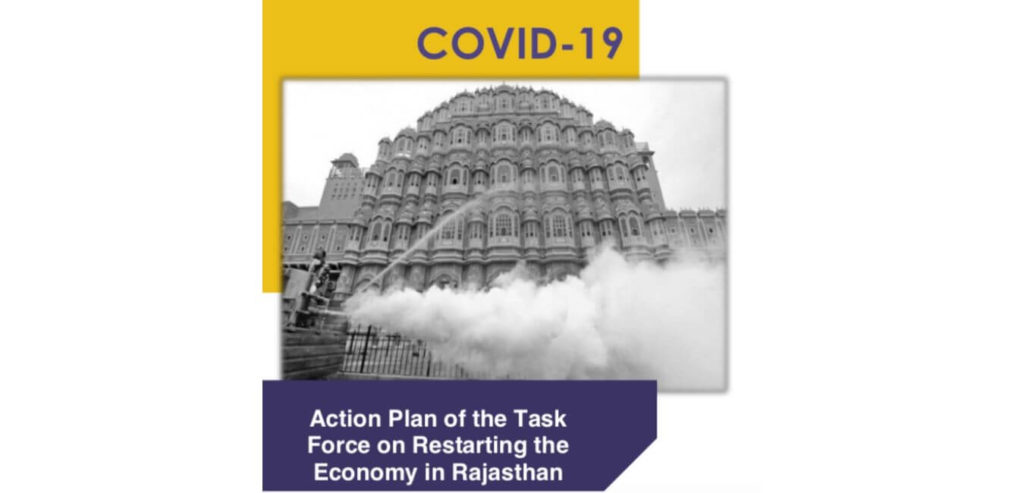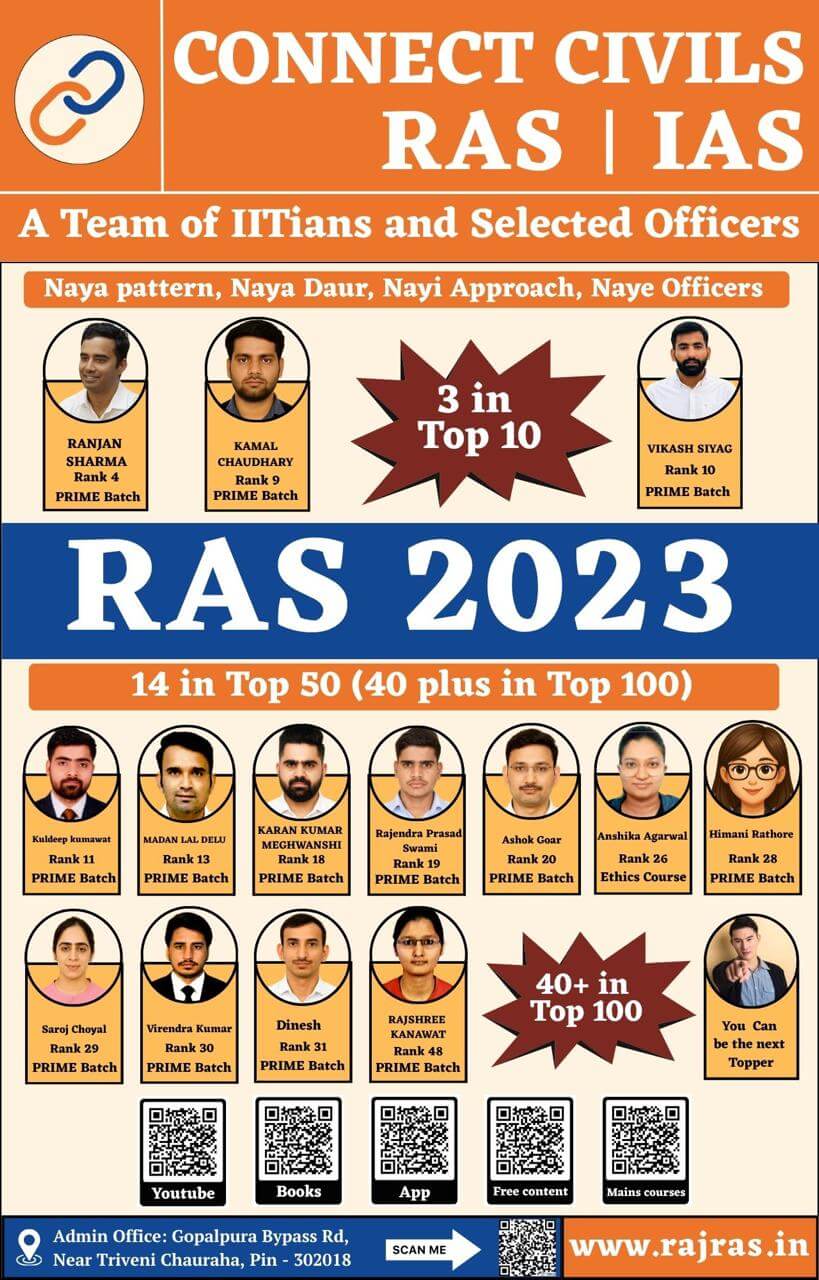Rajasthan Government had already started working on recovery plan post lockdown and had constituted two task forces for suggesting important measures for removing lockdown and formulate strategies to improve the economy post lockdown. On 13th April, the Second Task Force has come up with a detailed report titled “Action Plan of the Task Force on Restarting the Economy in Rajasthan“.
Action Plan of the Task Force on Restarting the Economy in Rajasthan
To minimize the impact Corona Virus Lockdown in State on people, the State Government has undertaken measures to maintain the supply chain of essential commodities, provide support in cash and kind to the weak and vulnerable.
However, a very coherent and comprehensive plan is required, with the full backing of the Government of India to restart economic activities and alleviate the suffering of the masses.
This report, therefore, lays emphasis on the need to synergize efforts of the state and the central government in meeting the economic challenge in a substantial measure. It then lays out a comprehensive strategy to restart economic activities in the state of Rajasthan.
Who has made this Report
The Report has primarily been compiled by Task Force 2, constituted by the Chief Minister under the Chairmanship of Arvind Mayaram, Economic Advisor to Chief Minister and Vice Chairman, CM’s Rajasthan Economic Transformation Advisory Council.
However the team has also taken inputs from individual experts, state government departments and private organisations like FICCI, Assocham, Confederation of Indian Industry (CII), Federation of Rajasthan Handicraft Exporters (FORHEX), Skoch Group, KPMG & McKinsey & Company etc.
Contents of the Report
This is enunciated in four sections:
- Section 1 deals with economic impact of COVID-19 and measures to contain it,
- Section 2 contains broad framework on which economic strategy is developed,
- Section 3 entails sectoral strategy and
- Section 4 contains other steps that the Government may take to generate confidence in economy and its revival plan.
OVERALL OBJECTIVE
Restart economic activities while maintaining some restrictions on crowding and social mixing.
TASK 1: IDENTIFY PRIORITY ACTIVITIES AND RESTART CONSISTENT WITH NECESSARY RESTRICTIONS ON MOVEMENT OF PEOPLE AND VEHICLES
- Restart wholesale and retail supply chains
- Commence in a limited manner mining and industrial operations where feasible
- Intensify Rabi crop cutting and functioning of mandis as well as preparation for the Kharif season to the maximum extent feasible
- Commence retail activities in a restricted form to allow the last mile supply chains – from producer and distributor to the customer- This will both increase the reliability of supply and the quantum of aggregate demand to do this consistent with social distancing is a complex challenge but it will have to be overcome. The lazy option—to keep most retail activities shut- will only magnify economic distress and social unrest going forward
- Commence interstate and intrastate goods transport in a regulated manner for maintaining supply chains and preventing large scale shortages.
TASK 2: RAMP UP STATE’S FISCAL CAPACITY
- The state government does not have the resources to be able to feed people who are out of jobs or have lost livelihoods for much longer due to financial constraints.
- The central government has also not come up with a big stimulus programme that could provide some financial relief to the states to deal with prolonged complete lockdown.
- Once economic activities start, and are scaled up in a phased manner, large number of persons who are out of livelihoods will once again start earning and spending, creating a virtuous circularity to the economy, weak at first but stronger over time. This will both increase revenues and limit demands on public expenditure.
Report – Action Plan of the Task Force on Restarting the Economy in Rajasthan
Download PDF
CALIBRATING THE LOCKDOWN
Calibrated lifting of lockdown would have to be determined by the pattern of spread of contagion in the district. Robust data is now available on the spread of the contagion geographically in the state. It is also granular, hot spots and emerging hot spots can be mapped on real time basis. Therefore, the hotspots can also be narrowed down to particular areas within a district. On the basis of the available data, the districts can be divided into three categories.
RED Category Districts (Stage 3 Lockdown) –
Districts with more than 5 cases. At present from a total of 33 districts in the state there are 14 districts with more than 5 cases and would fall in the category of Red Category.
- If the concentration of the cases is in an urban area with the rural areas untouched by it, the hotspot can be narrowed down to the urban centre in the district.
- In such a district, the Collector should be declared as District Enforcement Officer with extraordinary powers to direct officers and staff of all state government departments to direct all efforts at control of the spread of the contagion and maintaining supply of essential items. It is important not to divide the authority of the Collector, irrespective of his inter-se seniority with officers of other departments.
- If there is no fresh case continuously for fifteen days, the district can be downgraded to the next below category.
- If out of these districts there is any district where there has been no fresh case for the last fifteen days and recovery rate is increasing, such districts could also be downgraded.
Restrictions:
- Complete lockdown of the areas that have developed as a hotspot, with total restrictions on movement of people.
- District Enforcement Officer (Collector) should appoint Area Officers over a population group of 5000 to oversee the logistics of ensuring supply of essential items, including vegetables and medicines.
- Within the lockdown area, BPL families and registered workers/MGNREGA families (till start of works) will be provided with a monthly stipend equivalent to minimum wages for a period of up to three months beyond the lifting of the lockdown. (This is the estimated time required for them to find employment or start their livelihoods once again.)
- Release some resources from the other category districts to focus maximum relief efforts and treatment resources in such hotspots.
- Antibody testing could also start when available to assess herd immunity in these areas.
- Pedal rickshaws and auto rickshaws with one passenger and two wheelers without accompanying passenger could be allowed from point to point.
- Restricted movement of three wheeler pickups for creating wholesale to retail supply chains at designated times to be allowed outside the hotspot areas.
- Retail shops, with regulated movement of customers maintaining the social distancing norms will open outside hotspot areas. The onus of ensuring this would be on the shopkeepers with a penalty on the defaulters.
- In any area, fifty percent of the shops, preferably not adjacent ones, may be allowed to be opened on alternate days. These should include all types of shops and not only the ones supplying essential items.
ORANGE Category Districts (Stage 2 Lockdown)
All districts where there are 5 or less cases but at least 1 on April 14. At present there are 11 districts in this category.
- Hotspots would be identified if evidence demands, to narrow down the area where contagion could spread. In case cases are random and proper quarantine has been imposed on them and their contacts, the other areas could resume economic activities with certain restrictions restriction on movement of vehicles within the district.
- Pedal rickshaws and auto rickshaws with one passenger and two wheelers without accompanying passing could be allowed from point to point.
- Restricted movement of three wheeler pickups for creating wholesale to retail supply chains as designated times allowed outside the hotspot areas.
- Retail shops, with regulated movement of customers maintaining the social distancing norms will open. The onus of ensuring this could be on the shopkeepers with a penalty on the defaulters.
- In any area outside the hotspot/quarantine zone, shops may be allowed to be opened. These should include all types of shops and not only the ones supplying essential items.
Green Category Districts (Stage 1 Lockdown)
Districts that have zero cases would be placed in this category. At present there are 9 districts in this category.
- The borders of the district would remain sealed for movement of passengers from outside except with permission from the Collector (to ensure that no infected person travels to the district from other areas).
- It is understood that there would still be some movement of people from one district to the other through unconventional routes, but the effort would be to minimise it.
- It must be noted that such movement happens even when there is a complete lockdown in the entire state.
- Inter-district/inter-state movement of goods transport will be allowed with adequate precautions like screening of the drivers and the accompanying staff at the borders.
- To avoid over-stretching of the resources, only certain routes may be identified by the district administration to allow inter-district/inter-state movement.
- Within the district all economic activities including movement of people can commence.
- These include functioning of the mandis and resumption of industrial and mining activities.
- General precaution regarding social distancing, wearing of cloth masks and personal hygiene should be followed diligently.
- Places of leisure, including parks, lakes, tourist sites, places of shopping and entertainment certified by the district administration as social distancing compliant can be restarted with restrictions.
- For instance, restaurants could function with 50% covers and adequate distancing between the tables.
- Restriction on number of persons using these places could also be imposed.
Note: Report was published on 13th April, so number of districts & category of any particular district may change with time.
Download the Report
- Report – Action Plan of the Task Force on Restarting the Economy in Rajasthan – Download PDF
Important Notice:
This is not a government or official website. This is private information site, where information has been provided for benefit of people. We have made all efforts to provide genuine information & only government sites have been used for reference. However, users are requested to first check and act only on information provided by official sites.
Note: the government websites, official website all have .gov.in or .nic.in at the end of their address.
Action Plan of the Task Force on Restarting the Economy in Rajasthan


